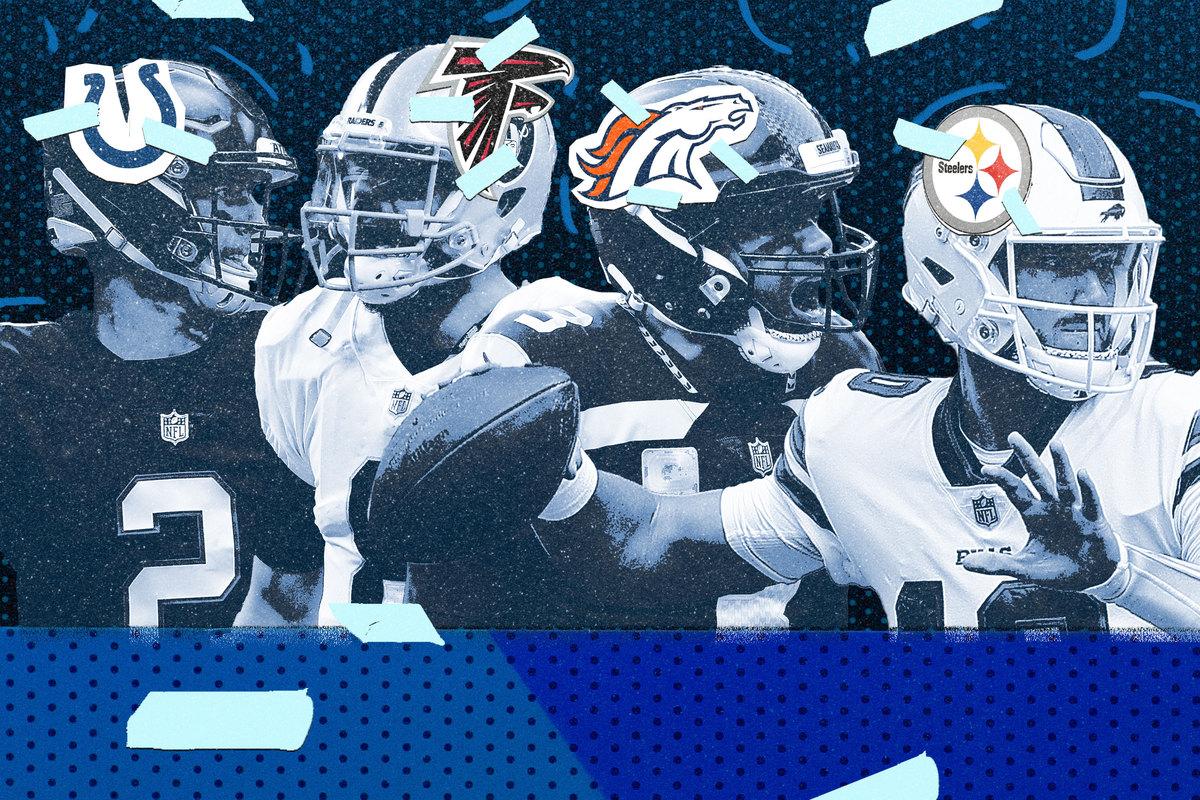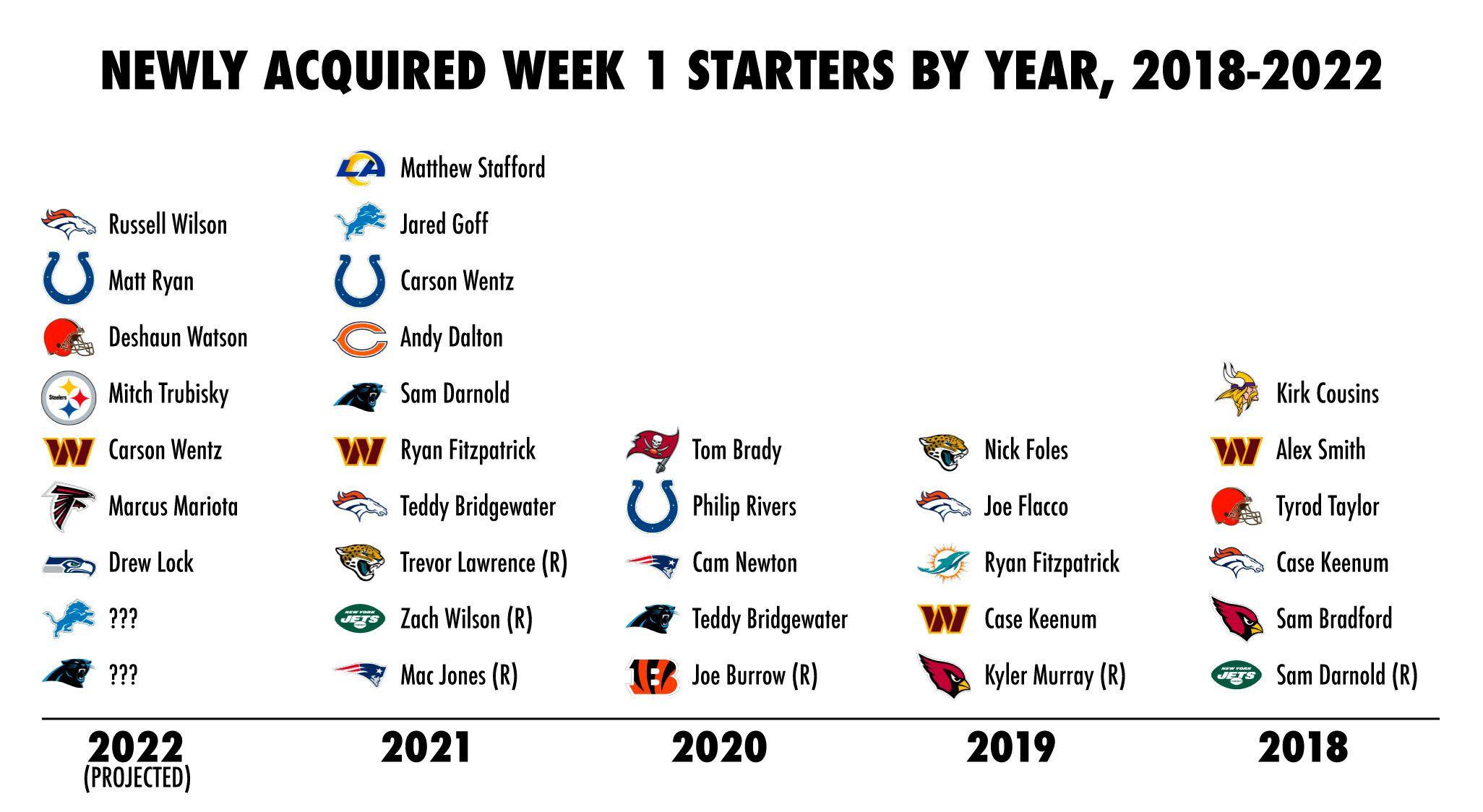
As recently as three seasons ago, NFL teams invoked a fairly risk-averse philosophy when it came to the quarterback position. If passers were any good, they generally got re-signed. Even the fact that Washington was willing to let Kirk Cousins—viewed as an above-average starter—hit free agency in 2018 seemed wild and risky.
But last year, the Lions traded away Matthew Stafford, the best QB in franchise history, for two first-round picks, a third-rounder, and whatever was left of Jared Goff’s dignity. This spring, we’ve seen Russell Wilson and Matt Ryan, two guys who also carried the “best QB in franchise history” label for the Seahawks and Falcons, respectively, also get dealt. Then there are Baker Mayfield and Jimmy Garoppolo, who aren’t in that class but have at least helped their current teams climb out of some dark times, and it seems both could be wearing different uniforms by September.
And those are just the trades! In 2020, the Patriots let the greatest quarterback of all time leave for Tampa. The Chargers let an aging but still productive Philip Rivers head off to Indianapolis. And while there are certainly still teams out there that are willing to cling to their forever quarterbacks until the end—Ben Roethlisberger’s body retired two years ago, and the Steelers were the only ones who didn’t realize it—it feels like today’s league has undergone a shift.
Look around the NFL right now and count how many quarterbacks you can confidently say will be starting for their current teams three years from now. Patrick Mahomes, Justin Herbert, and Josh Allen are definitely on that list. Lamar Jackson, Joe Burrow, and Dak Prescott are also probably locks to hold onto their current gigs. And … that might be it, if you exclude last year’s rookie class, which still has plenty left to prove.
This year, as many as nine teams—depending on how the Panthers and Lions approach the draft—could have a Week 1 starter who was not on the roster last season. And that’s a slight decline from 2021, when 10 teams acquired new starting quarterbacks in the offseason.

But we’ve seen more movement this offseason than in the three before 2021. And one thing that should immediately jump out is the quality of quarterbacks changing teams. Gone are the days of QB-needy teams fighting over Mike Glennon and Brock Osweiler in free agency. Those desperate clubs are now dreaming a bit bigger. The Broncos appeared to be shit out of luck at the start of March—a not unfamiliar feeling in Denver; a week later, they had a perennial MVP candidate in Wilson on their roster. The Colts were willing to ship Carson Wentz off to Washington without a viable replacement already in place before Ryan became available. And last week, the Browns had so alienated their starting quarterback that he demanded a trade and it looked as if Garoppolo would be their best option. Then they traded for Deshaun Watson. (How much Watson will play this season remains to be seen—the NFL is still investigating the 22 civil lawsuits for sexual misconduct filed against him.)
Last offseason, Broncos general manager George Paton was mocked for claiming that “quarterbacks are available more than franchise corners every year, at least the last couple of years”—partially because he said this after the team passed on Justin Fields and Mac Jones to draft Patrick Surtain II with the ninth overall pick. Hell, I was still mocking him for the comment earlier this month. But not long after I wrote that piece, Paton traded for Wilson, and Surtain, who’s entering his second season, already looks like an elite cornerback. If Paton hadn’t been so confident that a top-tier quarterback would be made available, Broncos fans might be talking themselves into Fields and, say, J.C. Jackson being enough to get them back to the playoffs. Instead, they’re viewing the team as a legitimate Super Bowl contender—and it’s not an irrational thought!
But before we can claim that this game of quarterback musical chairs will be a fixture of NFL offseasons going forward—and before teams start constructing their rosters with that in mind—we should analyze how we got to this point and try to determine what that past might mean for the future.
A large portion of this offseason’s quarterback carousel, which has to be the most eventful in modern NFL history, was the result of specific, unsettling circumstances. The morally bankrupt Watson sweepstakes impacted not only the Texans and Browns, but other teams who were trying to land the quarterback, like the Saints and Falcons. Mayfield requested a trade just after Cleveland met with Watson (whether that would have been honored had Watson not picked the Browns is another question). Then came the request from Ryan, who had a roster bonus date pushed back so the Falcons could continue to explore their options with Watson. The Saints decided to just run things back with Jameis Winston after their pursuit fell short.
Then there were the less fraught—if also major—moves. The Seahawks’ trade of Wilson to Denver was the biggest and most surprising deal of the offseason (so far). It’s really the only move that falls into the same genre as the Stafford trade, with a veteran quarterback deciding he wanted more from his team than it was capable of providing. Stafford’s breakup with the Lions wasn’t as public or as ugly as Wilson’s with Seattle—it was even framed as a “request” rather than a “demand”—but it was still Stafford who wanted to end the relationship, not the other way around. Brady’s split with the Pats the year before played out in a somewhat similar way. Their breakup was more of a mutual decision, but it was still the player who ultimately turned down an offer from the team and decided it was time to end things. So maybe this new NFL—in which a handful of established quarterbacks change teams every offseason—isn’t the product of front offices thinking differently about the position. Maybe it’s a matter of a few elite quarterbacks coincidently deciding to move on around the same time.
As a counterpoint to this, it’s instructive to look at the sub-elite quarterbacks who weren’t moved this offseason. Cousins, who has mostly been a disappointment in Minnesota, got a new one-year extension worth $35 million that will keep him in town through 2023. Derek Carr is staying put in Las Vegas, and instead of shopping for his replacement, the Raiders decided to spend a first-round pick, a second-rounder and $28 million a year to reunite Carr with his old college teammate, Davante Adams. The Dolphins watched Tua Tagovailoa destroy their playoff chances two seasons in a row and decided that bringing in Teddy Bridgewater as competition and Tyreek Hill as another speedy receiver was good enough for them.
After the Chiefs-Bills divisional-round playoff thriller in January, I wrote that the NFL’s new class of elite-superhuman quarterbacks had raised the standard for the “franchise quarterback” label. I believed that teams would be more willing to move on from quarterbacks who were productive but clearly not good enough to elevate the players around them to a championship level. But I may have had that backward: It now looks as if it’s the quarterbacks, and not the teams, who have raised their standards. If your current team isn’t willing or able to provide you a strong support system, find a team that will. And even if they are, there are ways to get them to invest both in you, and the rest of the team—like looking into a second career as a game show host.
We’ll have to wait a few years to draw firm conclusions on what this year’s wild quarterback market actually means, but teams can take one lesson away from the past couple of offseasons: There are 32 franchises, and only so many good quarterbacks to go around. You need them more than they need you.

